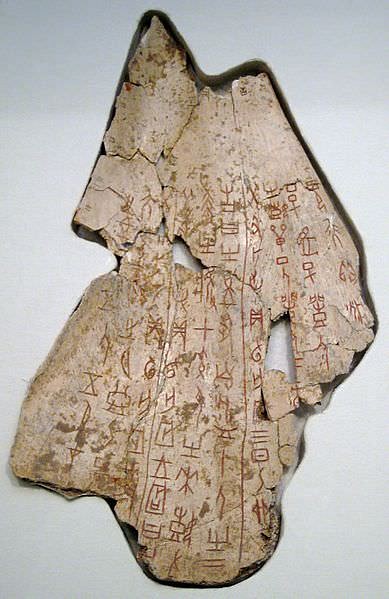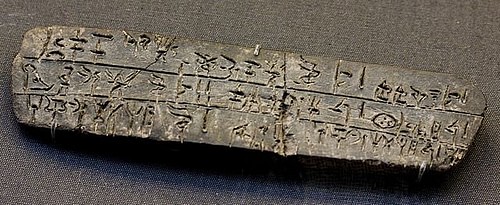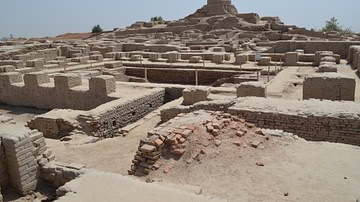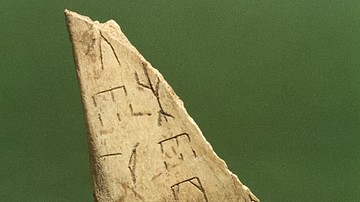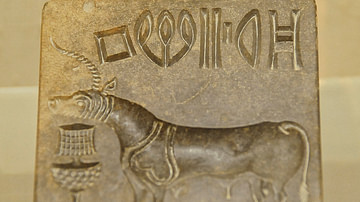
Script is the written expression of a language. Cuneiform, the first script, was invented in Sumer, Mesopotamia c. 3500 BCE, hieroglyphics sometime prior to the Early Dynastic Period in Egypt (c. 3150-2613 BCE), and Sanskrit in India during the Vedic Period (c. 1500 to c. 500 BCE). Writing was later adopted by other cultures enabling the development of civilization.
The period prior to the invention of writing is known as prehistoric when there was no written record of human thought and action. Archaeologists reconstruct this era through physical evidence such as grave goods, sites including Banpo Village in China or Skara Brae in Scotland, images on cave walls, and ancient refuse dumps. After script was invented, however, a written history of a civilization became available to supplement and clarify how the people lived and thought and, together, this provides the modern world with its history.
Script developed from simple to more complex writing systems:
- Pictographic (a symbol for an object, word, or phrase)
- Ideographic (a symbol for an object or concept such as the sign % for percent)
- Logographic (a symbol for an entire word or phrase)
- Phonographic (a symbol representing a sound)
- Alphabetic (less than 100 symbols (letters) used to form words representing objects and concepts)
The last three are still used in written languages today such as Chinese (logographic), Russian (phonographic), and English (alphabetic). Scholars continue to debate whether Mesopotamia, Egypt, or the Indus Valley Civilization first invented script, but generally, it is understood to have originated in Sumer. Once invented, it was then developed by other civilizations for communication, record keeping related to trade, and religious belief but, in time, would come to preserve every aspect of the human condition.
Mesopotamia & the Birth of Script
Script was first invented in Sumer c. 3500 BCE and revised c. 3200 BCE in the city of Uruk. Although the people of the Indus Valley Civilization (c. 7000-c. 600 BCE) are sometimes cited as the first, Indus script has not been deciphered, and the earliest inscriptions are dated to the middle or latter part of the Early Harappan Period (c. 5500-2800 BCE), after c. 3500 BCE. By that time, proto-cuneiform script had already been invented in Mesopotamia as well as the impression stamps known as cylinder seals, dating to c. 7600-6000 BCE. Scholar Stephen Bertman comments on the origin of script in Mesopotamia:
Vast and impressive as its impact was, writing's origins were simple and humble. The earth itself was its birthplace: the clay found beside its rivers was shaped in the hands to form small pillow-like tablets to write on, while the reeds that grew along the rivers' banks became tools. With the upper and lower parts of the stem neatly sliced off, the reed became a stylus and acquired a triangular cross-section that could be pressed into the soft clay. The wedge-shaped indentations later gave rise to a name for this style of writing, "cuneiform", from the Latin word "cuneus" for wedge. (144)
Script was invented to meet the needs that arose from trade in ancient Mesopotamia, as Bertman notes:
One thing is almost certain: necessity was the mother of invention. As each culture became economically and politically complex near the fourth millennium BCE, writing was devised as a way of keeping records. Each nation found in its own natural environment the raw materials it needed to become literate. (144)
In Mesopotamia, this began in the Uruk Period (4100-2900 BCE) and was fully developed by the Early Dynastic Period (2900-2334 BCE). The edubba ("House of Tablets") was the scribal school where script was taught and refined further so that, by c. 2600 BCE, literature was produced and activities of daily life recorded. The Instructions of Shuruppag, the oldest philosophical text in the world, is usually dated to c. 2000 BCE but could be as old as c. 2600 BCE and the first appearance of the hero-king Gilgamesh dates to c. 2150 BCE.
As writing developed as a craft, it required its own patron deity, first envisioned as the Sumerian goddess Nisaba and, later, the Babylonian god Nabu. These deities, like those of other civilizations, were thought to inspire scribes with the ability to capture concepts in script and preserve them for future generations to learn from. The ability to write and read script, in any culture, was highly regarded and works now known as literature were regularly attributed to divine inspiration and guidance, as noted by scholar Will Durant:
Literature is at first words rather than letters, despite its name; it arises as clerical chants or magic charms, recited usually by the priests, and transmitted orally from memory to memory. Carmina, as the Romans named poetry, meant both verses and charms; ode, among the Greeks, meant originally a magic spell; so did the English rune and lay, and the German Lied. Rhythm and meter, suggested, perhaps, by the rhythms of nature and bodily life, were apparently developed by magicians or shamans to preserve, transmit, and enhance the magic incantations of their verse. Out of these sacerdotal origins, the poet, the orator, and the historian were differentiated and secularized: the orator as the official lauder of the king or solicitor of the deity; the historian as the recorder of the royal deeds; the poet as the singer of originally sacred chants, the formulator and preserver of heroic legends, and the musician who put his tales to music for the instruction of populace and kings. (77)
The Mesopotamian scribe best-known for her literary works was the high priestess Enheduanna (l. 2285-2250 BCE), daughter of Sargon of Akkad (Sargon the Great, r. 2334-2279 BCE), the first author in the world known by name. Initially, cuneiform script was used to write the Sumerian language but during and after the Akkadian Period (2334-2218 BCE), it worked as well to write Akkadian and, later, the other languages of the Mesopotamian civilizations.
Egyptian Hieroglyphics
This same paradigm of the development of script is seen in other ancient cultures. In ancient Egypt, it was also invented to convey information on goods in long-distance trade. The earliest pictographic writing dates to the Predynastic Period in Egypt (c. 6000 to c. 3150 BCE) and had developed into hieroglyphic script by the Early Dynastic Period, as evidenced in the form of offering lists found in tombs.
As in Mesopotamia, the Egyptians credited the gods with the gift of script, and their literary deities were Thoth and Seshat. Seshat not only inspired Egyptian scribes but kept their works in a celestial library where they were thought to be preserved for eternity, encouraging the belief in writing as a means to immortality. The hope of eternal life through one's work, however, was only open to the scribe who wrote in the spirit of truth or, in other words, who was informed on the subject and whose work encouraged the recognition of cultural values. Scholar Margaret Bunson comments:
[In ancient Egypt, Thoth created script.] He was considered skilled in magic and became the patron of all scribes throughout the nation. Thoth appears in the Horus legends and was depicted in every age as the god who 'loved truth and hated abomination'. (Bunson, 264)
Before Egyptian scribes could write anything at all, however, they needed something to write on and with. Early Egyptian pictographs were carved on rocks and painted in tombs, and early hieroglyphic script followed this same pattern, until the invention of other materials. Bertman notes:
Around the same time in history [as the Sumerians created script], writing was invented in the valley of the Nile. There the Egyptians made use of a plant that grew in abundance along the river's banks, the papyrus plant. From its fibrous pulp, hammered flat and dried in the sun, they made the world's first paper. Indeed, our word "paper" comes from the ancient word"papyrus." From the loose fibers at the ends of the plant's stems, the Egyptians made brushes they used to apply ink to paper. (144)
Initially, script was used to write offering lists, an inventory of what was due to the deceased, written on the walls of their tomb. These lists could grow quite long and often included details of the person's life and a prayer for offerings. These early lists inspired the first works written on papyrus – prayers and autobiographies – which would eventually develop into Egyptian literature. The works of the Egyptian scribes were both fiction and nonfiction, religious and secular but, in anything written, they were understood to be representing the truth of their subject matter. Writing was a sacred craft in Egypt, and their script was known as medu-netjer ("the gods' words"), translated by the Greeks as hieroglyphics ("sacred carvings").
Chinese Scripts & Sanskrit
The association of the scribe with truth, with writing script as revealing and preserving truth, was a constant in other cultures as well. In China, the earliest script appears during the Shang Dynasty (1600-1046 BCE) around the year 1200 BCE through the use of oracle bones in the practice of divination. Questions, in the form of pictographs, were carved into the shell of a turtle or bone of an animal, and that object would then be exposed to intense heat. The resultant cracks in the shell or bone would provide the diviner with an answer to the question posed.
This answer, however, came not from the mortal diviner but from the divine realm and so was a recognizable truth. From this beginning, script evolved into the written expression of the spoken language of China. The four earliest Chinese scripts were:
- Jiaguwen – pictographic (used on oracle bones)
- Dazhuan – pictographic but more refined, developed c. 1000-700 BCE, also known as Greater Seal script
- Xiaozhuan – logographic, developed c. 700 BCE, also known as Lesser Seal script
- Lishu – logographic, developed c. 500 BCE, also known as Clerky script as it was used by government bureaucrats
Later scripts included Kaishu, Xingshu, and Caoshu, all developed during the Qin Dynasty (221-206 BCE) and Han Dynasty (206 BCE-220 CE). As in Egypt and Mesopotamia, Chinese scribes were expected to represent the truth in their writing, which meant being informed on the subject matter, and so, in any culture, a scribe was not only literate but highly educated. Chinese script was adopted by Japan, Korea, Vietnam, and the Khitan of Mongolia, as well as informing the Tangut Script of Tibet. As writing spread, so did the concept of the educated, informed scribe.
Script as a representation of truth and inspired by the gods is epitomized in the Rig Veda, the oldest of the Hindu scriptures known as the Vedas, from the Vedic Period. Sanskrit script developed in India by way of the Indo-Aryans (Aryan meaning "free" or "noble" and having nothing to do with race) and the Vedas – believed to be the actual words of the Universe – were passed down by oral tradition before they were committed to writing beginning c. 1500 BCE.
The Rig Veda, comprised of 10 books of hymns, addresses the basic philosophical questions of human existence including "What is the source of life?" and "How did the world come to be?" These questions were clearly asked, and their answers debated, for some time prior to the Vedic Period, but once script developed, the written work could be referenced, and others then created as commentary. By this process, the other Vedas were written as well as later commentaries on them. Sanskrit also allowed for the codified beliefs of Charvaka, Jainism, and Buddhism.
Phoenicia, Greece, & Rome
The ancient Greeks also used script early on to preserve their religious beliefs. The text known as The Room of the Chariot Tablets, the oldest known work written in Linear B script, dates to c. 1400-1200 BCE during the period of the Mycenaean Civilization (c. 1700-1100 BCE). The other early Greek script, Linear A script, remains undeciphered. The Room of the Chariot Tablets, while not strictly a religious text, lists many of the deities who appear in the Greek Pantheon of the later Classical Period.
The Phoenician alphabet was developed by c. 1100 BCE, adopted by the Greeks in the 9th-8th centuries BCE, and replaced Linear B script. The Iliad and Odyssey of Homer as well as Works and Days and the Theogony of Hesiod, all dated c. 8th century BCE, were written in the Greek alphabet as informed by the Phoenician system. According to Herodotus (l. c. 484-425-413 BCE), the alphabet was brought to Greece by the Phoenician Cadmus, best known as one of the earliest Greek heroes and legendary founder of Thebes:
The Phoenicians who came to Greece with Cadmus…ended up living in this land and introducing the Greeks to a number of accomplishments, most notably the alphabet, which, as far as I can tell, the Greeks did not have before then. At first, the letters they used were the same as those of all Phoenicians everywhere, but as time went by, along with the sound, they changed the way they wrote the letters as well. (V.58, Waterfield, 324)
Greek alphabetic script developed during roughly the same period as Etruscan script and these two, along with the Phoenician system, informed the Latin script of Rome. Although there is no connection between Latin and the cuneiform script of ancient Mesopotamia, the concept of representing language in script spread from Sumer throughout the ancient Mediterranean and, in other regions (such as Africa, Asia, and Mesoamerica), developed on its own. Latin script served the same purpose as Sanskrit or cuneiform, as Durant notes:
As trade connected tribes of diverse languages, some mutually intelligible mode of record and communication became desirable. Presumably the numerals were among the earliest written symbols, usually taking the form of parallel marks representing the fingers; we still call them fingers when we speak of them as digits. Such words as five, the German funf and the Greek pente go back to a root meaning hand; so the Roman numerals indicated fingers, 'V' represented an expanded hand and 'X' was merely two 'V's' connected at their points. Writing was in its beginnings a form of drawing, an art. (76)
This art of script would come to produce some of the most meaningful pieces of writing in the history of the world. From The Epic of Gilgamesh to the Hymn to Inanna of Enheduanna to the Egyptian Book of the Dead, the Analects of Confucius, the Mahabharata and Bhagavad-Gita, the Aeneid of Virgil as well as the trade agreements, correspondence, and other works written by the people of Mesopotamia, Egypt, China, Greece, India, Rome, and all the other cultures of the ancient world, script enabled not only communication but preservation; and preservation of the past established one's culture.
Conclusion
Script has served to communicate the most profound, as well as the most practical, aspects of the human condition. From the simple need to communicate across distances, writing systems became the means by which people preserved past knowledge, great advances, disappointments and disasters, offering those in the present the possibility of learning from the past by reading about earlier events and hearing from older voices, as Bertman notes:
The invention of writing was one of Mesopotamia's greatest achievements. It facilitated the organization and management of society and served as the chief instrument by which a complex civilization could come into being. Eventually, it became the medium through which the people's collective experience and wisdom were transgenerationally transmitted. Though Mesopotamia's languages and scripts ultimately became extinct, its invention of writing endured as its most lasting legacy to the modern world. (144)
A writing system is listed as one of the five factors necessary for the development of civilization. Although frequently taken for granted in the present day, script has been vital to the progress of humanity by providing people with a past to learn from and build upon while, at the same time, introducing and preserving concepts that are completely new or exploring questions that have been asked for millennia. From the clay tablets and reeds of Mesopotamia to modern-day email and ebooks, script allows one to communicate thoughts with others one may never meet over distances and between places the writers themselves may never see. To the ancient people, this was a gift from the gods to be held in reverence and, to many in the present day, it remains so.



